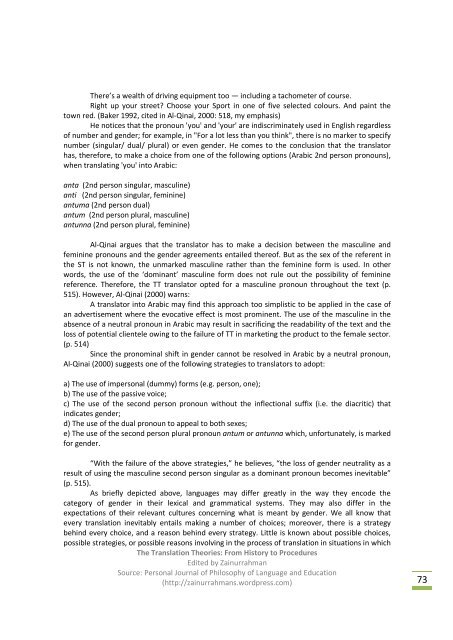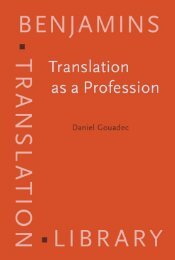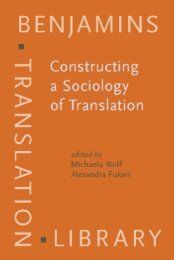Translation Theories.pdf
Translation Theories.pdf
Translation Theories.pdf
Create successful ePaper yourself
Turn your PDF publications into a flip-book with our unique Google optimized e-Paper software.
There’s a wealth of driving equipment too — including a tachometer of course.<br />
Right up your street Choose your Sport in one of five selected colours. And paint the<br />
town red. (Baker 1992, cited in Al-Qinai, 2000: 518, my emphasis)<br />
He notices that the pronoun 'you' and 'your' are indiscriminately used in English regardless<br />
of number and gender; for example, in "For a lot less than you think", there is no marker to specify<br />
number (singular/ dual/ plural) or even gender. He comes to the conclusion that the translator<br />
has, therefore, to make a choice from one of the following options (Arabic 2nd person pronouns),<br />
when translating 'you' into Arabic:<br />
anta (2nd person singular, masculine)<br />
anti (2nd person singular, feminine)<br />
antuma (2nd person dual)<br />
antum (2nd person plural, masculine)<br />
antunna (2nd person plural, feminine)<br />
Al-Qinai argues that the translator has to make a decision between the masculine and<br />
feminine pronouns and the gender agreements entailed thereof. But as the sex of the referent in<br />
the ST is not known, the unmarked masculine rather than the feminine form is used. In other<br />
words, the use of the ‘dominant’ masculine form does not rule out the possibility of feminine<br />
reference. Therefore, the TT translator opted for a masculine pronoun throughout the text (p.<br />
515). However, Al-Qinai (2000) warns:<br />
A translator into Arabic may find this approach too simplistic to be applied in the case of<br />
an advertisement where the evocative effect is most prominent. The use of the masculine in the<br />
absence of a neutral pronoun in Arabic may result in sacrificing the readability of the text and the<br />
loss of potential clientele owing to the failure of TT in marketing the product to the female sector.<br />
(p. 514)<br />
Since the pronominal shift in gender cannot be resolved in Arabic by a neutral pronoun,<br />
Al-Qinai (2000) suggests one of the following strategies to translators to adopt:<br />
a) The use of impersonal (dummy) forms (e.g. person, one);<br />
b) The use of the passive voice;<br />
c) The use of the second person pronoun without the inflectional suffix (i.e. the diacritic) that<br />
indicates gender;<br />
d) The use of the dual pronoun to appeal to both sexes;<br />
e) The use of the second person plural pronoun antum or antunna which, unfortunately, is marked<br />
for gender.<br />
“With the failure of the above strategies,” he believes, “the loss of gender neutrality as a<br />
result of using the masculine second person singular as a dominant pronoun becomes inevitable”<br />
(p. 515).<br />
As briefly depicted above, languages may differ greatly in the way they encode the<br />
category of gender in their lexical and grammatical systems. They may also differ in the<br />
expectations of their relevant cultures concerning what is meant by gender. We all know that<br />
every translation inevitably entails making a number of choices; moreover, there is a strategy<br />
behind every choice, and a reason behind every strategy. Little is known about possible choices,<br />
possible strategies, or possible reasons involving in the process of translation in situations in which<br />
The <strong>Translation</strong> <strong>Theories</strong>: From History to Procedures<br />
Edited by Zainurrahman<br />
Source: Personal Journal of Philosophy of Language and Education<br />
(http://zainurrahmans.wordpress.com) 73

















